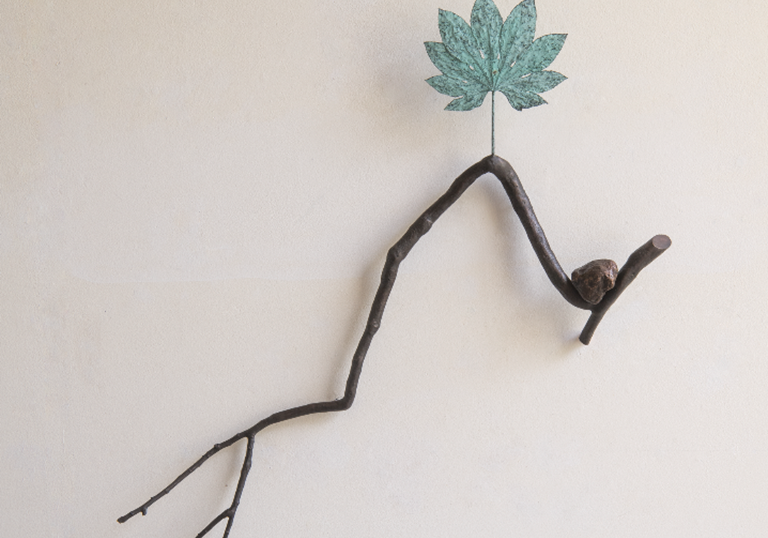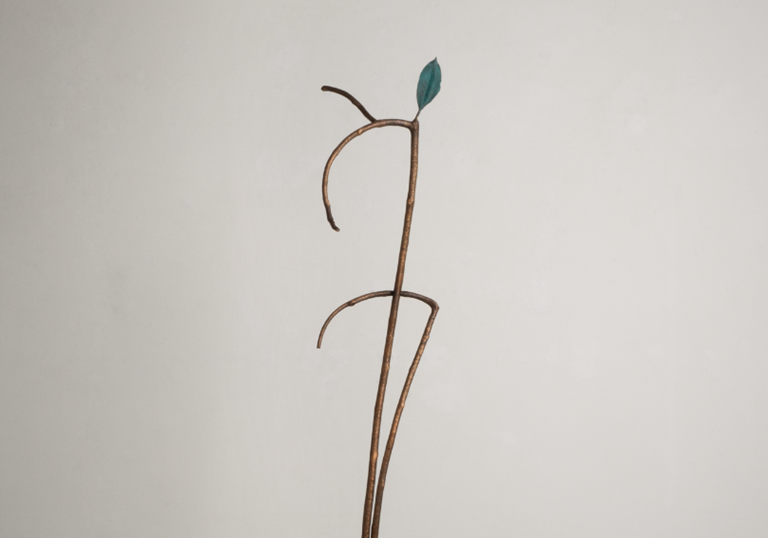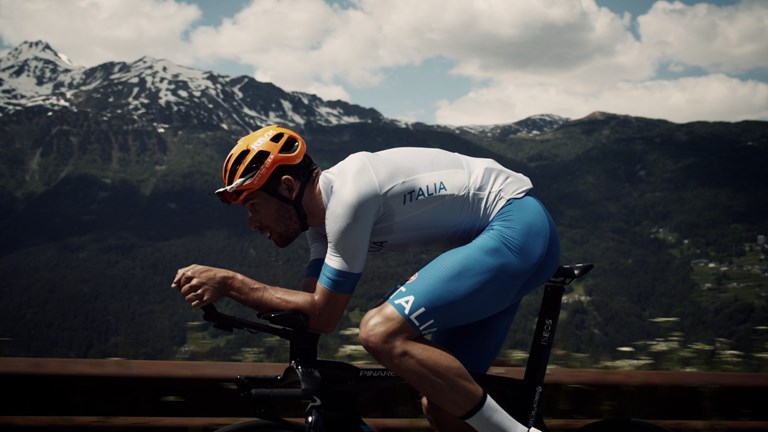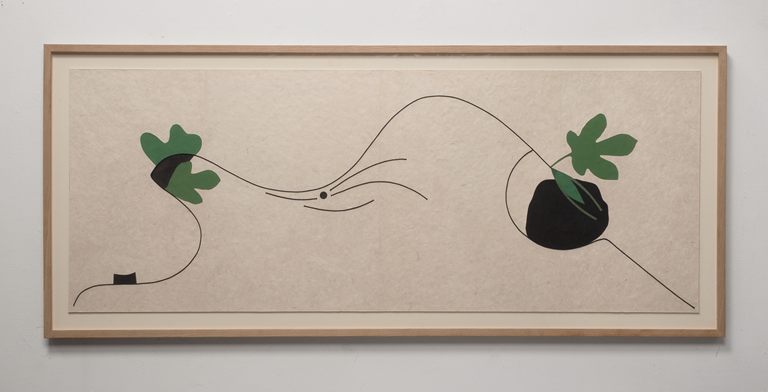
One thought of nature
A work by Flavio Paolucci calls us to a balancing act, a bit like some of his suspended installations. Faced with the shapes and colours found in the woods and brought back by the artist on canvas or in space, we feel involved in a dialogue between the randomness of natural production and the thought that abstracts, that evokes, that transforms the accident of a twisted branch into a metaphor of a condition that is both personal and universal.
With Paolucci, memory and exploration are reflected in each other. His works appear to us to open up on several paths; like the markers along the paths, they seem to tell us that there is something human out there, that can be expressed only through the signs created in the world.
Born on the days of the summer solstice 87 years ago, Paolucci is an artistic sun that continues to emanate its light. We met him in his studio in Biasca, during breaks in the shooting of a film about his work directed by Villi Hermann. The wall is covered with new work, and next to the armchair is a basket with dozens of pipes. Paolucci chooses one, holds it in his palm and begins to answer our questions.
Have you always dreamed of being a painter?
“Yes, since I was three years old, but for me to want to be a painter, meant to be a painter...”
Was anyone in your family an artist?
“No, my father was a labourer, we were not a wealthy family. An ancestor of mine had immigrated from Urbino.”
The homeland of Raffaello...
“I don’t think we’re related. In me, however, the vocation for art was strong, so I chose to attend the cantonal school of decoration and then I started working at the Atelier Oscar Bölt in Locarno.”
Then you discovered the Academy...
“Yes, I enrolled in Fine Arts in Brera, Milan. My point of reference was the Sironian tradition. I started with figurative paintings, then in the sixties with the experiences in Paris and Morocco I moved to an abstract naturalism, then I continued to experiment and deal with the developments of contemporary art.”
Like Arte Povera...
“Without a doubt, it is a movement to which I felt very close.”
The reference to natural elements is always present in your work, why?
“I was born in the Blenio Valley, in the midst of nature. My childhood memories are linked to the woods, to village tales, to a world for which nature was the regulator of life. This is why my inspiration comes from a walk, from what a branch found on the river bank or walking among the trees communicates to me. Leaves, trunks, bird’s eggs, any natural element can become a source of inspiration.”
The reference to nature is present in the shapes but also in the materials, in the colours...
“Yes, I have always tried to use colours that recall the natural ones or that are. Hence the use of dyes extracted from natural products, such as walnuts, or the use of soot taken from fireplaces, which represents the fire and therefore the nature that man tries to tame. Also, in the archaic sacred, the chimney was considered the one that allowed the souls of the dead to free themselves in heaven. The paper that I use for my works is also a handmade paper produced in Nepal using the wood of a small shrub that grows in that area. It has an excellent yield, gives materiality and naturalness to the works.”
In some of your works there is instead the reference to the form of nature but then a transformation into metal takes place.
“Yes, the branches or natural forms that inspire me are transformed into casts and then become bronze sculptures.”
Is there a way to make the idea contained in that natural object eternal?
“Of course, I start from a form that recalls nature, since it comes from it, but that is able to evoke other associations of ideas, practices or human emotions. A bow, an embrace, an effort.”
Is your art a work of subtraction?
“Yes, I try to reconstruct a world starting from the essential, from elementary things. The shapes, the lines, the space, the contrasts, the materials. I offer matter and symbolism, in which the viewer of the work can find echoes and assonances of his own relationship with nature and culture. It is an invitation to a journey.”
You have been working in the field of art for almost seventy years, has your inspiration, your desire to paint, to create, changed?
“I have to say that the desire to express myself through art and the desire to communicate emotions and visions have remained the same as when I started. That’s one of the great things about being an artist, you do what you like to do, what you feel is your vocation, and it’s something that time doesn’t affect.”
Have you had any pupils?
“Over the years, many young people have come and gone, but in the art world it is difficult to have pupils, because every artist reinterprets in his own way, with his own sensitivity, history, culture and tradition, what he learns from the masters.”
Has the art market changed?
“Certainly, the role of critics and gallery owners has changed. There is a greater attention to pop art, more immediate taste. However, I continue my research and am not influenced by it at all.”
What’s your last exhibition?
“In 2021 the Museum Art Plus of Donaueschingen, in Germany, in the area of the Black Forest, dedicated me a solo exhibition with works of the 1990s and 2000s.
Let’s go through the catalogue, we’ll stop at page 36. There is an empty frame crossed by a vertical line that continues in a rope that, under the frame, supports a rod. The title is “The wire of the acrobat”. On the side a phrase: “The acrobat loves to walk his rope to infinity.”
We just add: also the artist Flavio Paolucci.
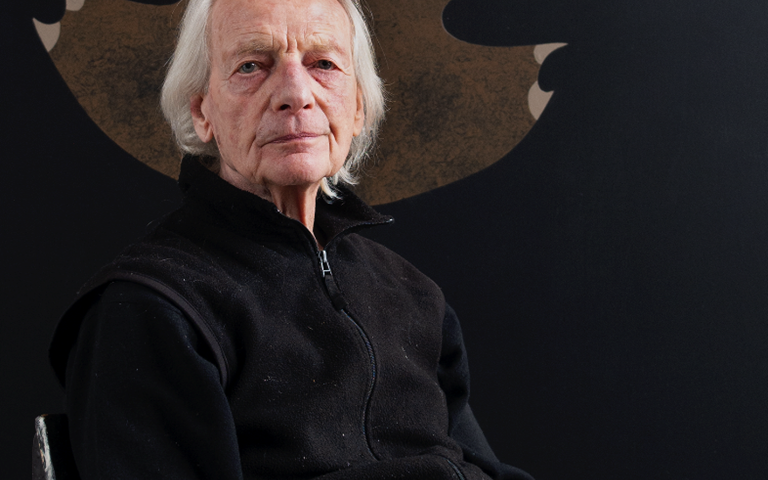
Flavio Paolucci
Year of birth: 1934
Profession: artist
Born in Torre, in the Val di Blenio, Paolucci after attending the Cantonal School of Painting in Lugano (1949-1953) and working at the Atelier Oscar Bölt in Locarno (1955), enrolled at the Accademia di Brera in Milan (1955-57). Under the influence of Aldo Carpi he studied Mario Sironi, Achille Funi and learned the technique of fresco painting. He made his debut with his first solo exhibition in 1958, the year in which he also won the first prize at the Biennale dei Giovani in Gorizia. In the early ‘60s he made some study trips. In Paris, in 1961, he received the second prize at the International Exhibition of Unesco. In 1964 he resided for a year in Morocco, where he discovered a totally different dimension of space and time; in 1967 he renewed his Moroccan experience. Since 1968 he has lived in his atelier on the outskirts of Biasca. First solo exhibition in a museum and first monograph in 1984 (Olten, Kunstmuseum); important retrospectives in Lugano (1988 and 2014), Locarno (1993) and Milan (1995). Among his solo shows were those at the Centre Culturel Suisse in Paris in 1987 and again at the Kunstmuseum in Olten in 2000.


